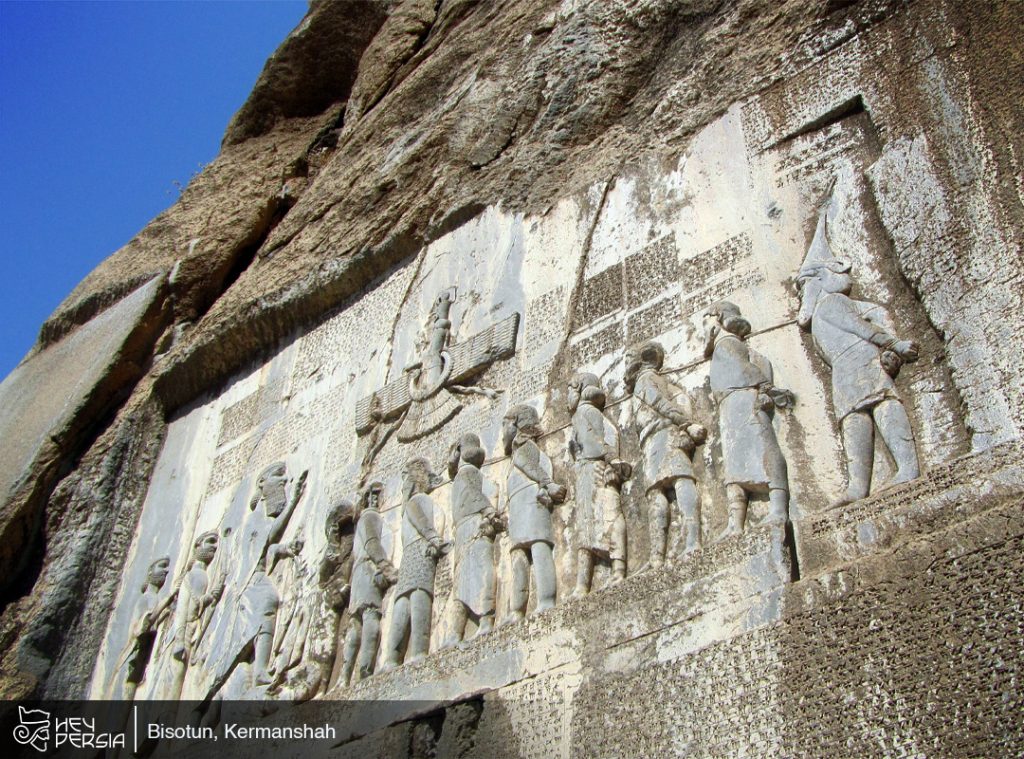Nestled in the western region of Iran, near the city of Kermanshah, Bisotun is a place of profound historical and cultural significance. At its heart lies the Inscription, a UNESCO World Heritage Site that provides a remarkable window into the ancient world. Bisotun in the Heart of Kermanshah, Iran will welcome you. Learn more at Hey persia.
Origin and Inscription of Bisotun in the Heart of Kermanshah
Generally, The history of Bisotun is intrinsically linked to the Achaemenid Empire, one of the ancient world’s most influential and expansive empires. The Behistun Inscription, known locally as “Bisotun,” is a massive rock relief and multilingual inscription that was commissioned by Darius the Great, the Achaemenid king, around 520 BC. It was carved into a sheer limestone cliff on Mount Bisotun, providing a unique and enduring record of the Achaemenid era.
Multilingual Marvel in Bisotun in the Heart of Kermanshah
Accordingly, The Bisotun Inscription is remarkable for its multilingual composition. It is inscribed in three ancient scripts: Old Persian, Elamite, and Akkadian. These scripts were accompanied by corresponding translations, effectively making it the world’s first known trilingual text. This linguistic diversity was strategically employed to communicate Darius’s authority and accomplishments across his vast empire.
Historical Narrative of Bisotun in the Heart of Kermanshah
Furthermore, The inscription itself narrates significant historical events, particularly the rise to power of Darius the Great. It recounts Darius’s struggles to establish his rule, including his defeat of rebellious regional leaders. The detailed account provides valuable insights into the political dynamics, military campaigns, and social structure of the Achaemenid Empire.

Archaeological Marvels
Additionally, The multilingual text, the Bisotun site features a remarkable rock relief depicting Darius the Great. The relief shows Darius standing triumphantly over his defeated enemies, symbolizing his authority and victory. The artistry and precision of the carving are a testament to the skill of ancient Persian craftsmen.
Historical Legacy
The Bisotun Inscription is not only a historical record but also a symbol of Persian cultural heritage. It stands as a testament to the achievements of the Achaemenid Empire, which played a pivotal role in shaping the course of ancient history. The inscription’s preservation is crucial for understanding the cultural and political dynamics of the time.
UNESCO World Heritage Site
Generally, In recognition of its exceptional historical and cultural value, the Behistun Inscription was designated as a UNESCO World Heritage Site in 2006. This designation underscores its significance on a global scale and highlights the importance of its preservation for future generations.
Preservation and Accessibility
Preserving the Behistun Inscription is of paramount importance. Over the centuries, it has faced natural erosion, weathering, and potential damage from human activities. Conservation efforts, including protective measures and ongoing maintenance, are essential to safeguard this invaluable historical artifact.
Visitor Experience
Accordingly, Bisotun welcomes visitors from around the world who come to witness the Behistun Inscription’s grandeur and historical significance. The site offers a unique opportunity for travelers, historians, and archaeologists to connect with Iran’s rich past. Guided tours and informative displays provide context and insights into the inscription’s historical narrative.
Bisotun in the Heart of Kermanshah
Bisotun, with its Inscription, is a living testament to Iran’s ancient history and cultural legacy. This remarkable site serves as a bridge between the present and the Achaemenid Empire, offering a glimpse into the ambitions, achievements, and struggles of a bygone era. Its UNESCO World Heritage status underscores its global importance, and its ongoing preservation ensures that future generations will continue to marvel at the historical marvel that is the Inscription, making Bisotun a timeless cultural treasure in the heart of Kermanshah, Iran.








